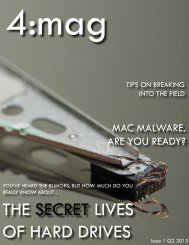You also want an ePaper? Increase the reach of your titles
YUMPU automatically turns print PDFs into web optimized ePapers that Google loves.
14<br />
however some variants reportedly<br />
delete these files after<br />
installation. An example is rh-<br />
3.jar or cl-3.jar. A malware file<br />
named .sysenter was found in<br />
the /tmp (/private/tmp) directory<br />
while the files in /Users/<br />
/Library/Caches/Java/<br />
cache/ can be deleted in an attempt<br />
to remove the malicious<br />
Java applets.<br />
Web Browser History & Cache<br />
Files – The web history files<br />
may contain known compromised<br />
websites such as ustream.rr.nu<br />
or gangstasparadise.rr.nu<br />
(rr.nu seems to<br />
be the TLD of choice.) The<br />
browser cache files may contain<br />
fragments of downloaded<br />
compromised sites that contain<br />
JavaScript code that was<br />
inserted into them to redirect<br />
to these domains.<br />
Root of User’s Home Directory<br />
– The user’s home directory<br />
can be used to store a downloader<br />
module of the malware.<br />
The filename is known to be<br />
randomly generated and hidden<br />
file as it has a dot ‘.’ as the<br />
first character in the filename.<br />
The User’s LaunchAgents Directory<br />
– This directory (/<br />
Users//Library/LaunchAgents)<br />
is used for malware<br />
persistence; it uses a property<br />
list file referencing the file created<br />
in the user’s home directory.<br />
This directory is used by a<br />
variety of applications to start<br />
services and helper programs<br />
when a user logs into the machine.<br />
One particular variant<br />
uses the property list filename<br />
com.java.update.plist with a<br />
reference to the file .jupdate in<br />
the user’s home directory.<br />
4:<strong>mag</strong> - issue <strong>#1</strong> <strong>Q2</strong> <strong>2013</strong><br />
Application Bundles – Depending<br />
on whether user credentials<br />
were given when the<br />
malware was installed, there<br />
may be files in Application<br />
Bundles. If credentials are given,<br />
the Safari.app bundle may<br />
contain two hidden files with<br />
.png and .xsl extensions in the<br />
/Applications/Safari.app/Contents/Resources/<br />
directory.<br />
References to these files can<br />
be found in the Info.plist in the<br />
/Applications/Safari.app/Contents/<br />
directory. If the user<br />
does not provide credentials, a<br />
file named .libgmalloc.dylib is<br />
created in /Users/Shared/ and<br />
a property list named environment.plist<br />
is created or modified<br />
in the /Users/.MacOS/ directory.<br />
This property list file<br />
references the .libgmalloc.dylib<br />
file. These file installations will<br />
allow the malware to hook into<br />
the Safari.app or any launched<br />
applications.<br />
Logs – The secure.log as shown<br />
to provide another resource to<br />
find evidence of malware installation;<br />
the malware uses<br />
/bin/sh to run an installation<br />
script. Tom Webb of irhowto.<br />
wordpress.com gives a great<br />
visual example of this.<br />
tiBetAn-relAted MAc<br />
MAlwAre<br />
Each of these pieces of malware<br />
targets Tibetan Non-Governmental<br />
Organizations (NGOs)<br />
using various techniques.<br />
lAMAdAi<br />
Lamadai installs is a backdoor<br />
that targets Mac and Windows<br />
systems using one of the same<br />
Java vulnerabilities as Flash-<br />
back (CVE-2011-3544) via an<br />
email with a link to a malicious<br />
website.<br />
Many of the same locations previously<br />
suggested may contain<br />
evidence of these infections.<br />
Look in the temporary directories<br />
for .jar files and in the<br />
Internet history for the domain<br />
dns.assyra.com. This particular<br />
malware sample uses the<br />
user’s LaunchAgents directory<br />
as before but with a different<br />
filename, com.apple.DockActions.plist<br />
and a reference to<br />
an executable in the /Library/<br />
Audio/Plug-Ins/AudioServer/<br />
directory. The targeted email<br />
may be found in the user’s<br />
favorite email program files,<br />
whether it is Apple Mail, Microsoft<br />
Outlook, Firefox Thunderbird,<br />
or a webmail client.<br />
sABpuB<br />
SabPab exploits a Java vulnerability<br />
(CVE-2012-0507 again<br />
Decoy Word Document (I<strong>mag</strong>e Source:<br />
http://totaldefense.com/blogs/2012/04/18/<br />
OSX/SabPub-New-Backdoor-Malware-Threatfor-Mac-OS-X.aspx)




